高中英语必修1Unit3Travel Journal
- 格式:ppt
- 大小:11.96 MB
- 文档页数:58
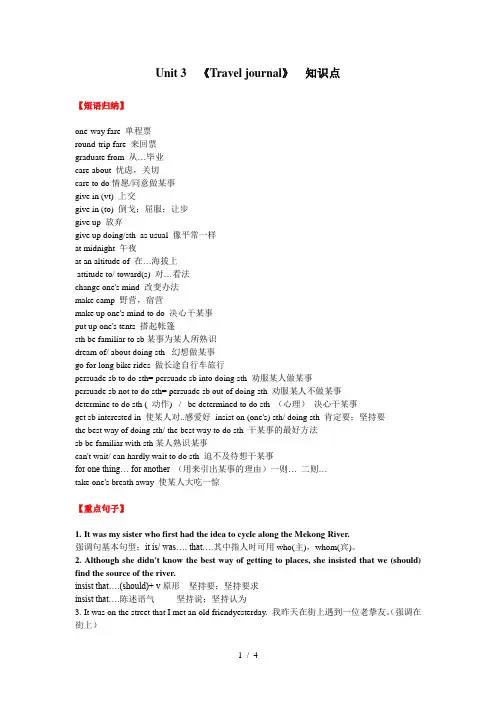
Unit 3 《Travel journal》知识点【短语归纳】one-way fare 单程票round-trip fare 来回票graduate from 从…毕业care about 忧虑,关切care to do情愿/同意做某事give in (vt) 上交give in (to) 倒戈;屈服;让步give up 放弃give up doing/sth as usual 像平常一样at midnight 午夜at an altitude of 在…海拔上attitude to/ toward(s) 对…看法change one's mind 改变办法make camp 野营,宿营make up one's mind to do 决心干某事put up one's tents 搭起帐篷sth be familiar to sb某事为某人所熟识dream of/ about doing sth 幻想做某事go for long bike rides 做长途自行车旅行persuade sb to do sth= persuade sb into doing sth 劝服某人做某事persuade sb not to do sth= persuade sb out of doing sth 劝服某人不做某事determine to do sth ( 动作) / be determined to do sth (心理)决心干某事get sb interested in 使某人对..感爱好insist on (one's) sth/ doing sth 肯定要;坚持要the best way of doing sth/ the best way to do sth 干某事的最好方法sb be familiar with sth某人熟识某事can't wait/ can hardly wait to do sth 迫不及待想干某事for one thing… for another (用来引出某事的理由)一则… 二则…take one's breath away 使某人大吃一惊【重点句子】1.It was my sister who first had the idea to cycle along the Mekong River.强调句基本句型:it is/ was…. that….其中指人时可用who(主),whom(宾)。
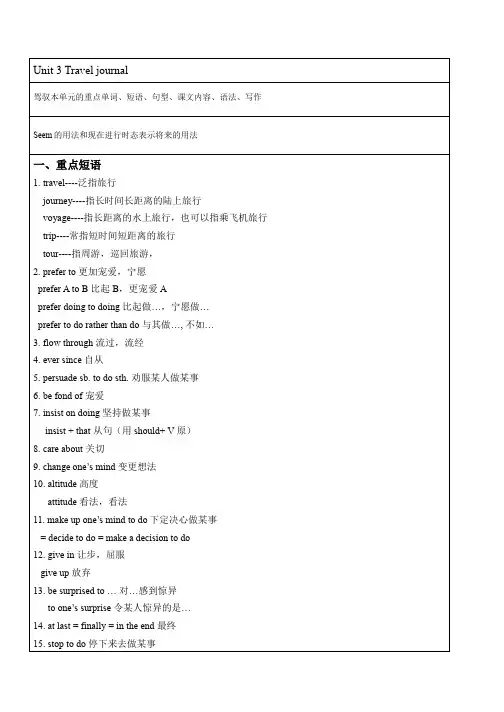
stop doing 停止做某事16. as usual 像平常一样17. so…that 如此… 以至于…So + adj + a/an + n. + thatSuch + a/an +adj. + n. + that18. be familiar with 对…熟识(人作主语)be familiar to 为…所熟识(物作主语)二、学问要点1. Which kind of transport do you prefer to use: bus or train?prefer v.更宠爱;选择某事物(而不选择其他事物)(1)prefer sth.更宠爱……prefer (sb.) to do sth.更宠爱(某人)做……prefer that更宠爱[that从句中常用(should)+动词原形]prefer sth./doing...to sth./doing...与……相比更宠爱……;宁愿……,不愿……e.g. I would prefer meat to fish.我宠爱肉赛过(宠爱)鱼。
I prefer singing to acting. 我宠爱唱歌赛过演戏。
prefer to do...rather than do...宁可……也不……e.g. He prefers to stay at home rather than go shopping.他宁可呆在家里也不情愿去逛商店。
(2)preference n. 偏爱;爱好;宠爱give preference to sb./sth.给……以实惠;优待2. Then she persuade me to buy one.然后她动员我也买了一辆.persuade vt.劝服; 劝服; vi.被劝服persuade sb. (not) to do sth.persuade sb. into / out of doing sth.e.g. I persuaded him to do it. = persuade him into doing it.我已劝服他做这件事。
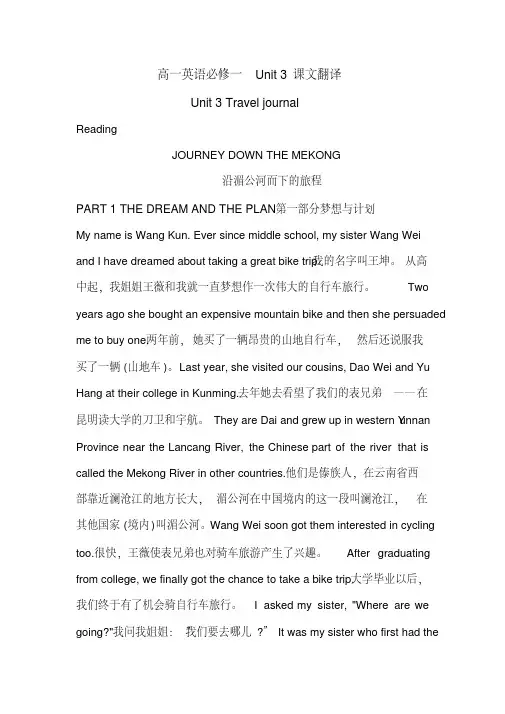
高一英语必修一Unit 3课文翻译Unit 3 Travel journalReadingJOURNEY DOWN THE MEKONG沿湄公河而下的旅程PART 1 THE DREAM AND THE PLAN第一部分梦想与计划My name is Wang Kun. Ever since middle school, my sister Wang Weiand I have dreamed about taking a great bike trip.我的名字叫王坤。
从高中起,我姐姐王薇和我就一直梦想作一次伟大的自行车旅行。
Two years ago she bought an expensive mountain bike and then she persuaded me to buy one.两年前,她买了一辆昂贵的山地自行车,然后还说服我买了一辆(山地车)。
Last year, she visited our cousins, Dao Wei and Yu Hang at their college in Kunming.去年她去看望了我们的表兄弟——在昆明读大学的刀卫和宇航。
They are Dai and grew up in western Y unnan Province near the Lancang River, the Chinese part of the river that is called the Mekong River in other countries.他们是傣族人,在云南省西部靠近澜沧江的地方长大,湄公河在中国境内的这一段叫澜沧江,在其他国家(境内)叫湄公河。
Wang Wei soon got them interested in cycling too.很快,王薇使表兄弟也对骑车旅游产生了兴趣。
After graduating from college, we finally got the chance to take a bike trip.大学毕业以后,我们终于有了机会骑自行车旅行。
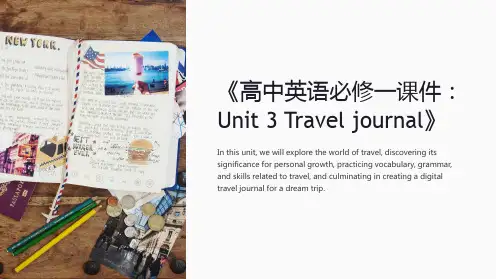
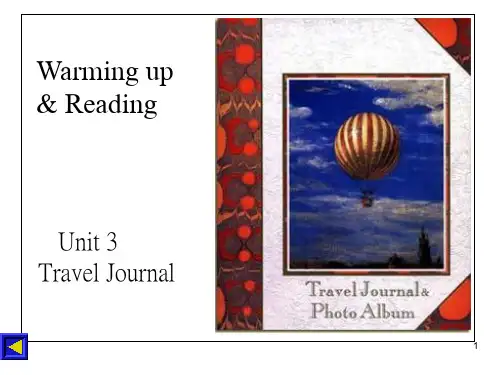
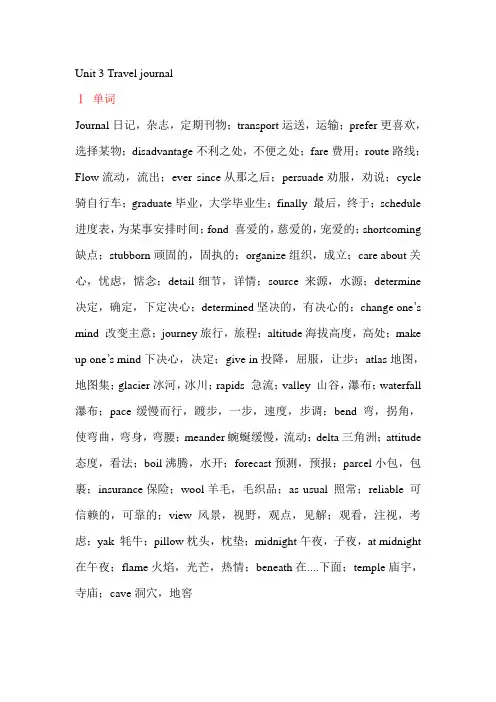
Unit 3 Travel journalⅠ单词Journal日记,杂志,定期刊物;transport运送,运输;prefer更喜欢,选择某物;disadvantage不利之处,不便之处;fare费用;route路线;Flow流动,流出;ever since从那之后;persuade劝服,劝说;cycle 骑自行车;graduate毕业,大学毕业生;finally 最后,终于;schedule 进度表,为某事安排时间;fond 喜爱的,慈爱的,宠爱的;shortcoming 缺点;stubborn顽固的,固执的;organize组织,成立;care about关心,忧虑,惦念;detail细节,详情;source 来源,水源;determine 决定,确定,下定决心;determined坚决的,有决心的;change one’s mind 改变主意;journey旅行,旅程;altitude海拔高度,高处;make up one’s mind下决心,决定;give in投降,屈服,让步;atlas地图,地图集;glacier冰河,冰川;rapids 急流;valley 山谷,瀑布;waterfall 瀑布;pace缓慢而行,踱步,一步,速度,步调;bend 弯,拐角,使弯曲,弯身,弯腰;meander蜿蜒缓慢,流动;delta三角洲;attitude 态度,看法;boil沸腾,水开;forecast预测,预报;parcel小包,包裹;insurance保险;wool羊毛,毛织品;as usual 照常;reliable 可信赖的,可靠的;view风景,视野,观点,见解;观看,注视,考虑;yak 牦牛;pillow枕头,枕垫;midnight午夜,子夜,at midnight 在午夜;flame火焰,光芒,热情;beneath在....下面;temple庙宇,寺庙;cave洞穴,地窖Ⅱ短语Persuade sb to do sth 劝服某人去做某事;Get the chance to do sth有做某事的机会;Be fond of sth/sb 喜欢某事/某人; keep doing sth 坚持做某事So......that......Ⅲ语法比较级;倍数Ⅳ写作TravelingWhen how where who whatⅤ翻译1)It was already midnight when we found the cave.2)There is a temple in the mountain whose altitude is more than 3000 meters.3)It starts to burn furiously with bright flame and the water in the bottle is boiling.4)This store sells high-qualified wool pillow and quilt.5)Tens of thousands of butterflies are coming to the river from everywhere each year.6)He seems to be a kind and reliable person, but in fact, he only cares about his money.7)Children are building sand castle beneath the blue sky.。
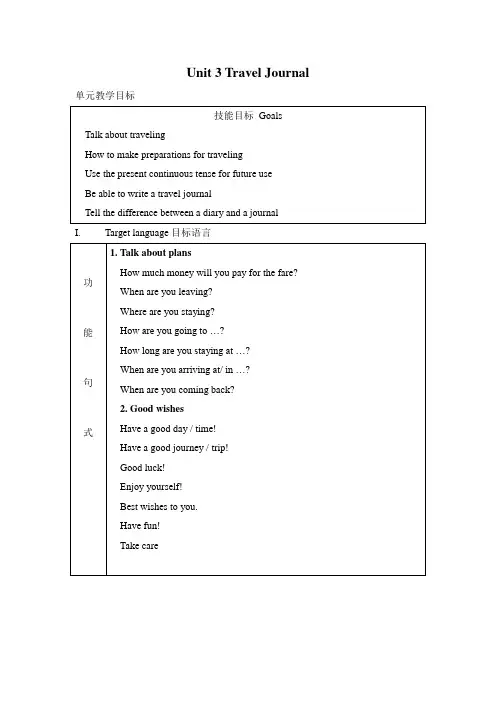
Unit 3 Travel Journal 单元教学目标I.Target language目标语言Ⅲ教材分析与组合1. 教材分析本单元以travel为主题,使学生通过travel了解他们所去国家或地区的风土人情,地理地貌及气候特征。
让学生体会英语作为工具给他们带来的乐趣。
学生可以利用英语扩大自己的视野,获取知识,了解世界。
学生可以通过相互讨论和相互交流以丰富各自的地理知识。
进一步扩大学生的词汇量。
能正确使用现在进行时的形式表达将来的计划和安排。
本单元把Travel Down the Mekong分成六部分,其中三部分作为阅读材料而另三部分作为听力材料。
通过本单元的学习使学生掌握一些重要词汇及词组,并能够写出自己的旅行日志来提高自己的写作水平。
1.1 Warming-up 让学生想象去旅游并选择一个地方为题,讨论所需费用,并决定四种交通方式,使学生了解旅行前的准备及计划。
1.2 Pre-reading 部分的三个问题是通过讨论河流在人民生活中的作用以及看图回答问题,让学生找到湄公河流域的国家,作为阅读的“热身”1.3 Reading 是日志的第一部分,它讲述了王坤和王薇的骑车旅行梦想和计划,描述了他们为这次旅游所做的准备,对旅游路线的选定以及他们通过查阅地图对湄公河情况的了解。
文章用第一人称的方式,通过对王薇做事的方式的介绍,让大家了解了她的性格特点,使人倍感亲切,给人留下深刻的印象。
日志的第二部分放在workbook 中,主要讲述他们在西藏山中度过的一宿,以及旅行中的苦与乐。
1.4 Comprehending第一题是信息题,通过问答使学生进一步理解课文以训练学生获取信息的能力。
第二题是理解题,让学生用自己的话解释课文中的句子。
第三题是推断题,让学生通过主人公的行为来推断他们对旅行的态度。
第四、五题是语言运用题,用以提高学生运用语言的能力。
1.5 Learning about language分两部分,第一部分是旨在通过三个题型的练习使学生掌握目标语言。
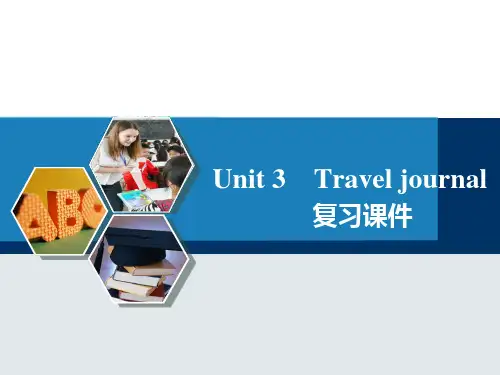
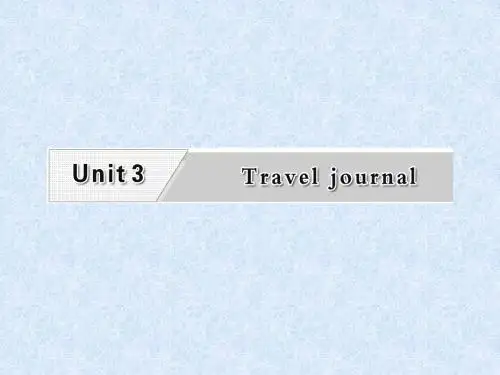
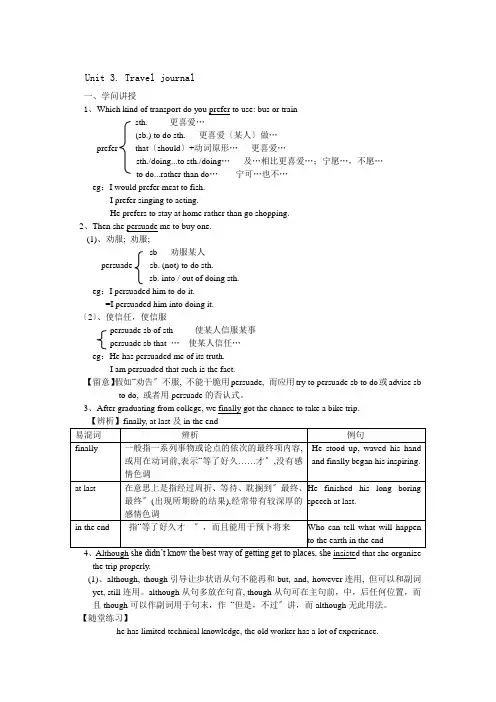
Unit 3. Travel journal一、学问讲授1、Which kind of transport do you prefer to use: bus or trainsth. 更喜爱…(sb.) to do sth. 更喜爱〔某人〕做…prefer that 〔should 〕+动词原形… 更喜爱…sth./doing...to sth./doing … 及…相比更喜爱…;宁愿…,不愿…to do...rather than do … 宁可…也不…eg :I would prefer meat to fish.I prefer singing to acting.He prefers to stay at home rather than go shopping.2、Then she persuade me to buy one.(1)、劝服; 劝服;sb 劝服某人persuade sb. (not) to do sth.sb. into / out of doing sth.eg :I persuaded him to do it.=I persuaded him into doing it.〔2〕、使信任,使信服persuade sb of sth 使某人信服某事persuade sb that … 使某人信任…eg :He has persuaded me of its truth.I am persuaded that such is the fact.【留意】假如“劝告〞不服, 不能干脆用persuade, 而应用try to persuade sb to do 或advise sbto do, 或者用persuade 的否认式。
3、After graduating from college, we finally got the chance to take a bike trip.、Although she didn’t know the best way of getting get to places, she insisted that she organize the trip properly.(1)、although, though 引导让步状语从句不能再和but, and, however 连用, 但可以和副词yet, still 连用。
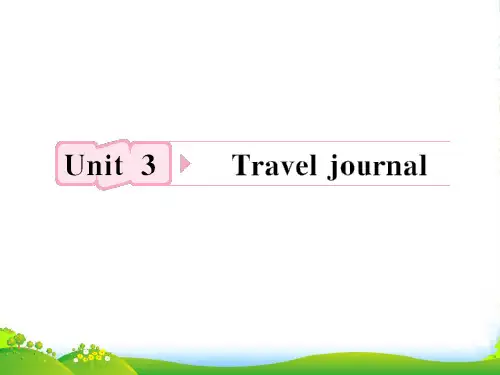
北师大版高中英语必修一第三单元教案全文共3篇示例,供读者参考篇1Unit 3 Travel journal1. Teaching aims:a. Enable students to master some vocabulary related to travel.b. Enable students to grasp some important sentence structures and expressions.c. Cultivate students' listening, speaking, writing and reading skills.d. Cultivate students' interest in writing travel journals.2. Teaching key pointsa. Key vocabulary related to travelb. Important sentence structures and expressionsc. Writing skills for travel journals3. Teaching difficult pointsa. How to use the vocabulary and sentence structures in practical situations.b. How to write a coherent and interesting travel journal.4. Teaching aidsa. Multimedia resourcesb. Whiteboard and markers5. Teaching proceduresStep 1: Warm-up (10 minutes)a. Show students some pictures of famous tourist attractions around the world and ask them if they have ever been to any of them.b. Discuss with students the reasons why people travel and the benefits of traveling.Step 2: Vocabulary learning (15 minutes)a. Introduce some key vocabulary related to travel, such as "destination", "sightseeing", "accommodation", "itinerary", etc.b. Have students practice using the vocabulary in sentences.Step 3: Listening and speaking practice (20 minutes)a. Play a recording of a travel journal entry and have students listen carefully.b. Ask students to discuss in pairs or small groups about their own travel experiences and share them with the class.Step 4: Writing practice (30 minutes)a. Introduce the format and structure of a travel journal entry.b. Have students write their own travel journal entry about a trip they have taken or would like to take.c. Provide feedback and corrections on students' writing.Step 5: Review and assessment (15 minutes)a. Review the key vocabulary and sentence structures learned in the lesson.b. Have students present their travel journal entries to the class for assessment.6. Homeworka. Ask students to continue their travel journal entries at home and bring them to the next class for review.b. Assign some exercises related to the vocabulary and sentence structures learned in the lesson for further practice.Through this lesson, students will not only improve their English language skills, but also develop a greater appreciation for the art of travel journal writing.篇2北师大版高中英语必修一第三单元教案Unit 3 Travel journalⅠ. Teaching aims and requirements1. Knowledge aims:(1) Get to know some news words: trek, snowcapped, spiritual, kingdom, Kingdom, camel.(2) Understand the main idea of each para., comprehend some detailed information to Mary and Mood.(3) Practice reading skills: skimming and scanning.2. Ability aim:Improve students’ abilities of listening, speaking, reading and wring. Learn how to express travel through it.3. Emotion aim:(1) Cultivate students’ travel mind and prepare their travel ideas.(2) Learn to respect, peaceful and grateful.4. Moral aim:Learn to natural world to love, to know animals and treasure life’s creatures.Ⅱ. Teaching key points1. Summary the passage: Why does Mary Bishop come to the Nepal Himalaya?2. How did she feel after leaving the snow-capped mountain?3. What about another member’s mood?Ⅲ. Teaching difficult points1. Improve students’ summarizing ability.2. Ingrain climate.Ⅳ. Teaching aidsA recorder, a computer and multi-media.Ⅴ. Teaching methodsTask-based teaching. Communicative approach.Ⅵ. Teaching proceduresStep Ⅰ: Lead-in1. Show some cards about the animals and choose the most important animal in their heart.2. Ask: Why do they feel meet?3. Listen to the tape for warming up.Step Ⅱ: Pre-reading.Predict what they may feel during trekking in the Himalayas and give their an example then scan Task1Q1.Step Ⅲ: Reading1. Students read the passage quickly and choose the answer about Mary loses while trekking.2. To teacher’s questions: What’s wrong with Mary’s friend?3. Analyze detailed information of Mood.4. Check the work and ask some questions to each other and fill in the blanks.Step Ⅳ: Comprehension1. Listen to Task2Q2 to particular. They can draw a map to explain that she arrives in Jiri and then to Sethopsar.2. Find the detailed from the passage and fill in the blanks.3. Pair works to discuss mood for 2 minutes.Step Ⅴ: Language practice1. Help student to speak: In pairs. Practice speaking these dialogues.2. To help them to translate Chinese into English.Step Ⅵ: SummaryAsk students to try their best to speak in English about their thoughts when meet animals in trekking.Step Ⅶ: Homework1. Choose another paragraph to summarize.2. Writing an essay with their parents talking about experience of trekking.Ⅶ. Blackboard designUnit 3 Travel JournalMain Idea: Why does Mary Bishop come to the Nepal Himalaya?a) ...........b)...............c)…………Task 1Fill in the blanks.1. The writer saw many ---------.2. There was a dog following the trek who tried to--------.3. In the evening, they camped in a beautiful ---------.Task 2Write down your answers in the passage.1. Travel to Tsomanthang.2. Go to Sethopsar.ConclusionImprove students' summarizing and comprehension abilities.篇3Lesson 3 One's company, two's a crowd, three's a party【Teaching Aims】1. Enable students to master the key words and expressions in the text.2. Improve students' listening, speaking, reading and writing skills.3. Develop students' ability to express their opinions and thoughts in English.4. Cultivate students' understanding of different cultures and social norms.【Teaching Key Points】1. Key words and expressions in the text.2. Listening comprehension.3. Speaking practice based on the text.4. Writing a short paragraph expressing personal opinions.【Teaching Difficult Points】1. Listening comprehension.2. Expressing personal opinions and thoughts in English.【Teaching Methods】1. Task-based teaching method.2. Group discussion.3. Pair work.4. Role play.5. Multimedia teaching.【Teaching Procedures】Step 1: Greeting and warm-up (5 minutes)- Greet the students and introduce the topic of the lesson.- Ask students to discuss in pairs: "What do you think makes a good party?"- Have a brief class discussion to share ideas.Step 2: Pre-reading task (10 minutes)- Ask students to look at the title of the text and predict what it might be about.- Play a short video clip of a party scene and ask students to describe what they see and how they feel.Step 3: Reading and listening (20 minutes)- Read the text aloud and ask students to read along silently.- Play the audio recording of the text for students to listen and follow.- Discuss the main ideas, key words, and expressions in the text.Step 4: Reading comprehension (15 minutes)- Divide students into pairs or small groups to discuss and answer the comprehension questions.- Check the answers as a class and provide feedback.Step 5: Speaking practice (20 minutes)- Divide students into groups and assign roles for a role play activity about planning a party.- Encourage students to use the key words and expressions from the text in their conversations.- Monitor and provide feedback on their speaking skills.Step 6: Writing (15 minutes)- Ask students to write a short paragraph expressing their opinions on the importance of social gatherings.- Collect and review the paragraphs for grammar and vocabulary errors.Step 7: Summarizing and homework (5 minutes)- Summarize the key points of the lesson and ask students to review the text for homework.- Assign a writing task for students to write a party invitation using the key words and expressions from the text.【Teaching Reflection】This lesson aims to engage students in a variety of activities to improve their English skills while exploring the theme of social gatherings. By focusing on listening, speaking, reading, and writing tasks, students are able to practice and consolidate their language skills in a meaningful context. The use of multimedia and interactive activities helps to create a dynamic and engaging learning environment.。
高一英语必修一Unit 3课文翻译Unit 3 Travel journalReadingJOURNEY DOWN THE MEKONG沿湄公河而下的旅程PART 1 THE DREAM AND THE PLAN第一部分梦想与计划My name is Wang Kun. Ever since middle school, my sister Wang Wei and I have dreamed about taking a great bike trip.我的名字叫王坤。
从高中起,我姐姐王薇和我就一直梦想作一次伟大的自行车旅行。
Two years ago she bought an expensive mountain bike and then she persuaded me to buy one.两年前,她买了一辆昂贵的山地自行车,然后还说服我买了一辆(山地车)。
Last year, she visited our cousins, Dao Wei and Yu Hang at their college in Kunming.去年她去看望了我们的表兄弟——在昆明读大学的刀卫和宇航。
They are Dai and grew up in western Y unnan Province near the Lancang River, the Chinese part of the river that is called the Mekong River in other countries.他们是傣族人,在云南省西部靠近澜沧江的地方长大,湄公河在中国境内的这一段叫澜沧江,在其他国家(境内)叫湄公河。
Wang Wei soon got them interested in cycling too.很快,王薇使表兄弟也对骑车旅游产生了兴趣。
After graduating from college, we finally got the chance to take a bike trip.大学毕业以后,我们终于有了机会骑自行车旅行。
Unit 3 Travel Journal教材分析本单元的话题是旅游,学生对此话题较为熟悉,应该有较浓厚的兴趣。
整个单元讲述的是主人公“王坤”以旅行日记的形式详细地记录自己沿着湄公河而下的自行车旅行。
学生通过追随作者的旅行,学习及探讨与旅游相关话题和内容,如:了解旅游常识,如何设计旅行计划,如何为旅行做准备,旅行的意义等。
通过本单元的学习,学生不仅能掌握与旅游及地理相关的主题词汇,理解和运用现在进行时表示将来的语法项目,还会通过探讨旅游话题了解世界各地的文化,增强对祖国河山的热爱和国际意识,进而开拓学生思路,培养学生的跨文化交际能力。
Warming up 部分先让学生分享国庆假期的游玩经历,引导学生探讨节假日旅行的利与弊。
通过对比分析几种常见交通方式的利弊,择优选择自己旅行的最佳出行方式,并尝试为自己设计旅行计划。
Reading部分先通过Pre-reading的问题,引导学生关注世界各大河流及人类对河流的利用,和理解湄公河在东南亚的地位及对东南亚各国人民的重要作用。
课文主要介绍了主人公王坤和王薇的梦想及骑自行车沿着湄公河旅行的计划和准备。
在整体理解课文主要内容后重点引导学生分析王坤和王薇两位主人公的性格及对旅行的不同态度。
Learning about Language以文本核心单词与词组为直接学习内容,加强学生的英英释意习惯,让学生学会利用字典及参考书进行自主归纳与学习。
在本课时的词汇学习中强调在语境中正确理解和运用词汇;Using Language集听、说、读、写于一体。
先通过读旅行日记的第二部分来了解其文体特征及内容、听一段关于王坤与老挝女孩的一段对话、探讨自己对老挝感兴趣的话题,写一封email询问王坤的旅行情况;Grammar是学习现在进行时表示将来的用法,并进行操练。
引导学生通过观察对比例句,总结归纳现在进行时表将来的用法及规律,并在生活情境中正确运用该语法项目。
在本单元的Learning Tip中给学生提出写旅行日志的方法和好处,鼓励学生外出旅行时写旅游日志(travel journal).教学目标(1)学习理解旅行日记Journey down the Mekong的行程及主人公的所见所闻;(2)能够熟练掌握并运用现在进行时表示将来的语法项目;(3)帮助学生掌握正确的旅游常识,及培养学生的安全意识及保护自然的责任感。